
МИНИСТЕРСТВО ОБРАЗОВАНИЯ , НАУКИ И МОЛОДЁЖНОЙ ПОЛИТИКИ РЕСПУБЛИКИ КОМИ
ГОСУДАРСТВЕННОЕ ПРОФЕССИОНАЛЬНОЕ ОБРАЗОВАТЕЛЬНОЕ УЧРЕЖДЕНИЕ
«СЫКТЫВКАРСКИЙ ТОРГОВО-ТЕХНОЛОГИЧЕСКИЙ ТЕХНИКУМ»

МЕТОДИЧЕСКОЕ ПОСОБИЕ ПО АНГЛИЙСКОМУ ЯЗЫКУ
«INTERNATIONAL CUISINE»
для профессий и специальностей:
43.01.09 – «Повар, кондитер»
43.02.15 «Поварское и кондитерское дело»
Мареева Л.В
преподаватель английского языка
высшая квалификационная категория
г. Сыктывкар
2021
Английский язык: Учебное пособие. – Сыктывкар: СПО.
ГПОУ «СТТТ», 2020. – 72 с.
Автор-составитель: Мареева Л.В. преподаватель ГПОУ «СТТТ»
Данное учебное пособие предназначено для студентов техникума очного обучения для специальности:
43.02.15 «Поварское и кондитерское дело»
43.01.09 «Повар, кондитер»
Пособие рассчитано на аудиторную работу под руководством преподавателя, и на самостоятельную работу.
Учебное пособие состоит из лексико-грамматических темы “Кухня народов мира», изучавщейся на IV курсе.
Unit 1. – The world cuisines (Texts and exercises)
Unit 2- Recipes of dishes
Unit 3- Vocabulary
Unit 3. - Useful information
Unit 4.- Control work
Unit 5. - Quiz «guess the cuisine of the world by one dish»
- Сooking quiz «By country and continent»
Цель настоящего пособия
-формирование навыков работы с иноязычными текстами, навыков перевода, извлечения информации и её переработки на основе различных видов чтения, расширение активного и пассивного словарного запаса в профессиональной области.
-социокультурное воспитание обучающихся через ознакомление с кулинарными традициями и культурой питания разных народов;
Учебное пособие позволяет решать следующие задачи на уроке иностранного языка (английского):
ü совершенствование процесса качественного произношения слов;
ü введение и закрепление лексики;
ü работа над грамматикой;
ü совершенствование навыков устной речи;
ü знакомство учащихся с культурой англоязычных стран и др.
Пособие состоит из пяти разделов.. Специальная лексика вводится тематически, закрепляется в разнообразных упражнениях. Разделы включают в себя следующие задания:
ü прочитать и перевести текст;
ü дать ответы на вопросы к тексту;
ü заполнить пропуски подходящей по смыслу лексикой;
ü заполнить таблицу профессиональной информацией
Разработанные упражнения предназначены для организации закрепления содержания текстов.
Пояснительная записка
Данное учебное пособие содержит текстовые материалы по теме «Кухня народов мира» лексико-грамматические упражнения, тесты и контрольные работы, направленные на развитие навыков перевода, письменной и устной речи, тестовые задания и викторину по национальным кухням. Предлагаемые тексты и задания позволяют не только развивать и совершенствовать навыки владения иностранным языком, но и способствуют формированию профессиональной направленности в обучении студентов, интереса к будущей профессии. Тексты аутентичные, их уровень сложности варьируется, что позволяет использовать данное пособие в группах с различной языковой подготовкой. Пособие рекомендуется для студентов СПО, обучающихся по направлению «Поварское и кондитерское дело» и «Повар, кондитер»
Unit 1.
«Cuisine of the world»
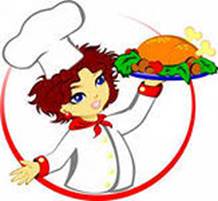
Every nation living on Earth has its own history, traditions and, of course, features of the national cuisine. A cuisine is a certain set of cooking traditions passed on from generation to generation. A cuisine is often named after the place where it originated. The choice of ingredients depends on the region or country.
For example, the Greeks use lots of tomatoes, olives, lemons and seafood in their dishes because these products are easily found in their country.
Today, if you want to taste the food of different countries, it’s not necessary to fly there. The restaurants of various cuisines can be found almost in every city. I live in Yekaterinburg and there are lots of Chinese, Japanese, French, Greek, Italian, Spanish and even Mexican restaurants here.
Chinese dishes are mostly made of rice and noodles. The thing that I like about this cuisine is the variety of green and herbal teas.
Japanese cuisine is based on fresh seafood, soybeans and white rice. I have already tried several types of rolls and sushi with soy sauce and it was rather delicious.
French cuisine is considered to be the most exquisite and refined of all. I have never tried French dishes but I’d love to. They say French cheese, wine and pastries are really good.
Greek food is delicious. My favourite dish is the Greek salad with fresh tomatoes, olives, bell peppers and tofu cheese.
I also like Italian food. It mainly offers different types of pizzas and pasta. I think, that Italian cuisine somehow reminds the Greek one because both these countries are situated in the Mediterranean.
Spanish cuisine offers lots of dishes from seafood and fresh vegetables. A good example of this cuisine is paella.
Mexican cuisine uses lots of spices and chili pepper. Famous Mexican dishes are tacos and quesadillas.
Tastes differ
1. Прочитайте , переведите и перескажите текст. Ответьте на вопрос письменно.
Tastes differ. It concerns food in the first place. A Frenchman will eat a fried frog with pleasure but a Russian would choose something different. Pigs are not eaten in Moslem countries though Europeans are fond of pork. A sandwich of raw meat is a delicacy for a German while in other countries it is not served. One may give many other facts to illustrate the above saying.
What explanations can you give to these customs?
2. Ответьте на вопросы по образцу.
Образец: Have you had any vegetables? (fruit)- I haven't had any vegetables. I have just had some fruit.
1. Has he had any beans? (peas)
2. Have they had any coffee? (tea)
3. Have you had any apples? (peaches)
4. Have I had any cabbage? (lettuce)
5. Have you had any beer? (wine)
6. Has he had any lamb? (beef)
7. Have they had any tea? (milk)
8. Has she had any meat? (vegetables)
9. Have you had any chicken? (steak)
3. Согласитесь или опровергните следующие утверждения.
l. Sandwich is a hot meal which we eat at dinner for the first course.
2. We have lunch in the evening before going to bed.
3. Englishmen usually do not have porridge in the morning.
4. Doctors usually recommend people to have heavy supper.
5. If you want to reduce your weight (to become slim) you must eat a lot of bread.
6. Tarts and cakes and fruit are usually served at the beginning of a meal.
4. Объясните значение пословиц:
1. The glutton digs his grave with his teeth.
2. The proof of the pudding is in the eating.
3. You can't eat a cake and have it.
4. The appetite comes with eating.
5. Man does not live by bread alone.
6. Too many cooks spoil the broth.
7. First catch your hare then cook him.
8. You cannot make an omelette without breaking eggs.
9. Enough is as good as a feast.
10. Hunger is the best sauce.
11. Dog does not eat dog.
Meals in Great Britain
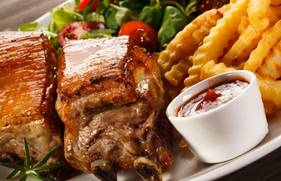
Some English people have their biggest meal in the middle of the day and some have it in the evening, but most people today have a small mid-day meal – usually sandwiches, and perhaps some crisps and some fruit.
The English have three main meals a day:
• Breakfast – between 7:00 and 9:00, • Lunch – between 12:00 and 1:30 p.m.
• Dinner (sometimes called Supper) – The main meal. Eaten anytime between 6:30 and 8:00 p.m. (Evening meal)
Traditionally, and for some people still, the meals are called:
• Breakfast – between 7:00 and 9:00 a.m.,
• Dinner (The main meal) – between 12:00 and 1:30 p.m.
• Tea – anywhere from 5:30 at night to 6:30 p.m.
On Sundays the main meal of the day is often eaten at midday instead of in the evening.
 BREAKFAST:
Most people around the world seem to think a typical English breakfast consists
of eggs, bacon, sausages, fried bread, mushrooms and baked beans all washed
down with a cup of coffee. Nowadays, however, a typical English breakfast is
more likely to be a bowl of cereals, a slice of toast, orange
juice and a cup of coffee.
BREAKFAST:
Most people around the world seem to think a typical English breakfast consists
of eggs, bacon, sausages, fried bread, mushrooms and baked beans all washed
down with a cup of coffee. Nowadays, however, a typical English breakfast is
more likely to be a bowl of cereals, a slice of toast, orange
juice and a cup of coffee.
Many people, especially children, in England will eat a bowl of cereal. They are made from different grains such as corn, wheat, oats, etc. In the winter many people will eat porridge or boiled oats.
The traditional English breakfast consists of eggs, bacon, sausages, fried bread, baked beans and mushrooms. Even though not many people will eat this for breakfast today, it is always served in hotels and guest houses around Britain. The traditional English breakfast is called the ‘Full English’ and sometimes referred to as “The Full English Fry-up”.
LUNCH: Many children at school and adults at work will have a ‘packed lunch’. This typically consists of a sandwich, a packet of crisps, a piece of fruit and a drink. The ‘packed lunch’ is kept in a plastic container. Sandwiches are also known as a ‘butty’ or ‘sarnie’ in some parts of the UK.
DINNER: The evening meal is usually called ‘tea’, ‘dinner’ or ‘supper’. A typical British meal for dinner is “meat and two veg”. They put hot brown gravy (traditionally made from the juices of the roast meat, but more often today from a packet!) on the meat and usually the vegetables. One of the vegetables is almost always potatoes.
The traditional meal is rarely eaten nowadays, apart from on Sundays. A recent survey found that most people in Britain eat curry! Rice or pasta dishes are now favoured as the ‘British Dinner’.
Vegetables grown in England, like potatoes, carrots, peas, cabbages and onions, are still very popular
The Sunday Roast dinner: Sunday lunch time is a typical time to eat the traditional Sunday Roast. Traditionally it consists of roast meat (cooked in the oven for about two hours), two different kinds of vegetables and potatoes with a Yorkshire pudding. The most common joints are beef, lamb or pork; chicken is also popular.
Beef is eaten with hot white horseradish sauce, pork with sweet apple sauce and lamb with green mint sauce. Gravy is poured over the meat.
Yorkshire pudding: This dish is not usually eaten as a dessert like other puddings but instead as part of the main course or at a starter. Yorkshire pudding, made from fl our, eggs and milk, is a sort of batter baked in the oven and usually moistened with gravy. The traditional way to eat a Yorkshire pudding is to have a large, fl at one fi lled with gravy and vegetables as a starter of the meal. Then when the meal is over, any unused puddings should be served with jam or ice-cream as a dessert.
II. Answer the following questions on the text.
1. How many meals a day do English people have?
2. What is a typical English breakfast?
3. What is a traditional English breakfast?
4. Where can you taste a traditional Fry-up?
5. What is another name for a sandwich in Britain?
6. What is a “packed lunch”?
7. What is a typical meal for dinner in England?
8. What vegetables are popular in Britain?
9. Why is curry known now as British?
10. What is a traditional Sunday Roast dinner?
11. What sauces are eaten with beef, pork and lamb?
12. What is Yorkshire pudding made from? How can it be eaten?
III. Express the following sentences in English using the information from the text.
1. Основной приём пищи – ужин, между 18.30 и 20.00.
2. Типичный английский завтрак состоит из яичницы, запеченных бобов, сосисок, бекона, жареного хлеба и грибов.
3. Мисочка зерновых хлопьев – типичный завтрак для детей в Англии. Зимой многие люди едят овсяную кашу.
4. Ланч состоит из сэндвича, пакета чипсов, какого-либо фрукта и напитка. Обычно ланч хранится в пластиковом контейнере.
5. Британцы поливают мясо коричневой подливкой. Они обычно едят мясо с овощами. Один из овощей – картофель.
6. Овощи, которые выращивают в Англии, – картофель, капуста, морковь, лук и горох.
7. Традиционный воскресный ужин состоит из жаркого, овощей и йоркширского пудинга.
8. Говядину едят с соусом из хрена, свинину – со сладким яблочным соусом, а баранину – с мятным соусом.
9. Йоркширский пудинг делают из муки, яиц и молока. Это своего рода жидкое тесто, запеченное в духовке.
10. Неиспользованные пудинги подаются с джемом или мороженым в качестве десерта.
1. Meals in the USA
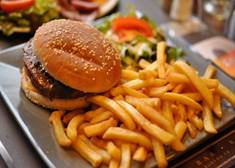
Americans usually have three meals a day: breakfast, lunch and dinner. All these three meals are served almost at the same time as in Britain.
Usual breakfast in the United States is orange juice, toast and coffee, or juice and dry cereal with milk, or eggs.
Lunch is usually a small meal – a sandwich, salad or soup, hamburgers and sausages.
Brunch in America is a combination of breakfast and lunch that many Americans enjoy on Sunday. It is usually served at about eleven in the morning. Scrambled eggs or omelets are often served along with other regular luncheon dishes. In many restaurants brunch is served from around 10 a.m. until midafternoon.
Dinner usually includes a main course of meat or fish accompanied by side dishes such as soup, salad and vegetables.
There are two main types of restaurants in the USA – fast-food and full-service restaurants. A fast-food restaurant is much like a cafeteria. Items such as hamburgers, hot chicken sandwiches, pizza and salads are typical of a fast-food restaurant. Eating in a fast-food restaurant takes less time and is less expensive than in a full-service restaurant.
Agree or disagree:
1. Translate from Russian into English, using your active vocabulary.
1.Мексиканская пища – самая любимая для многих американцев. 2. Многие годы американцы любили традиционный обильный завтрак и рацион из мяса и картофеля. 3. По всей стране много ресторанов быстрого питания. 4. На обед они всегда едят салат из различных овощей, смешанных с гренками и заправкой. 5. Американцы не едят селедку и редко едят суп. 6. В общем, американцы едят много, особенно в выходные дни. 7. Здоровая пища не содержит химических продуктов и консервантов. 8..Американцы любят разные напитки со льдом, такие как чай со льдом и лимоном, фруктовые соки или коктейли, а также просто воду со льдом. 9. Что касается полуфабрикатов, таких как замороженные овощи, лазанья, ризотто, паста, то американцы обычно покупают их вечером, чтобы приготовить дома ужин быстро и без особых проблем.
10.Фаст-фуд- любимая еда американцев.11. Зажаренная индейка-праздничное блюдо в Америке
2. Read the sentences and say “true” or “false”
1. Most Americans prefer having home-cooked lunch.
2. Chinese food is not popular with the Americans.
3. The Americans often prefer fast food: hamburgers, hot dogs, French fries.
4. The Americans never have salad for dinner.
5. American women like cooking and washing dishes.
6. The Americans like to have herring and soup for dinner.
7. They drink different kinds of gas water during any meal.
8. When the Americans go for a picnic, they often bake potatoes in the open-air fire.
1.Прочитайте и переведите текст на русский язык. Выполните задание по тексту.
Russian cuisine
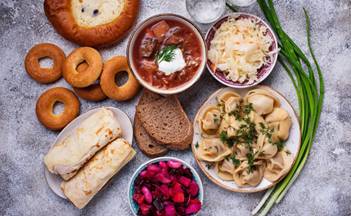
Russia is a huge country and that is why Russian cuisine is a rich collection of diverse cooking traditions. Russian food has its own peculiarities due to the country’s severe climate in winter and its forests rich in berries, mushrooms in summer. Traditional Russian dishes are often made of vegetables, different crops, dairy products, fresh-water fish, poultry and meat.
For breakfast Russian people usually have milk porridge, syrniki (cottage cheese pancakes) or an omelette. Lunch is more sufficient and it often consists of a salad, a plate of soup and a main course. For dinner the Russians love fish and meat dishes with garnish (rice, buckwheat, mashed potatoes and stewed cabbage). Traditional pelmeni (meat dumplings), holodetz (meat jelly with pieces of meat, carrot and garlic) or golubtsy (cabbage rolls with minced meat) are special masterpieces of the national culinary art. The Russians also have salads, meat pies, apple pies, vareniki (cottage cheese, cherries or potatoes dumplings) and pancakes for dinner.
The most traditional Russian salads are Olivier, “Dressed herring” and Vinaigrette. All of them are a nourishing mixture of various ingredients such as boiled eggs, boiled vegetables (potatoes, carrots, beetroot), sausage or meat, onions, green peas and cucumbers.
Russian cuisine is famous for the variety of soups: shchi (cabbage soup), borshch (red beetroot soup), ukha (fish soup), solyanka (thick soup made of pickled veggies, meat and sausage) and rassolnik (pickle soup). A plate of hot and spicy soup helps to stay warm during long cold winters. And one of the favourite soups during hot summers is okroshka (cold vegetable and sausage soup based on kvas). All kinds of soups are normally dressed with sour-cream. It is notable that Russian people eat bread with all dishes.
Traditional Russian drinks are hot black tea with jam or honey, compote (stewed fruit drink) and kvas (drink made from rye bread).
The Russians are good at preserving fruits, vegetables and mushrooms. Classic Russian appetizers: pickled cabbage, tomatoes, crispy cucumbers and even apples – are always on a festive table.
Russian people have always been known for their hospitality. They are happy to welcome guests with lavish dinners with abundance of food on the table.
2.Найдите в тексте следующие эквиваленты:
Богатая коллекция разнообразных кулинарных традиций; леса, богатые ягодами и грибами; рыбные и мясные блюда с гарниром; мясное желе с кусочками мяса, моркови и чеснока; питательная смесь из различных ингредиентов, тарелка горячего пряного супа; напиток из сушеных фруктов; густой суп из маринованных овощей, мяса и колбасных изделий.
3. Ответьте на вопросы по тексту:
1. What are traditional Russian dishes often made of?
2. What do the Russians love for dinner?
3.What ingredients are there in a nourishing mixture of “Dressed herring” and Vinaigrette?
4. What soups is Russian cuisine famous for?
5. What favourite soup do the Russians love to eat during hot summers?
6. What traditional Russian drinks do the Russians love?
7. What are the classic Russian appetizers always on the festive table?
Caucasian cuisine
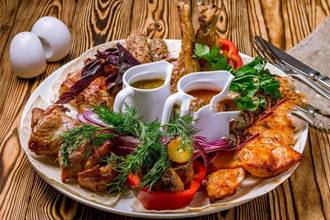
1.Прочитайте и переведите текст на русский язык. Выполните задание по тексту.
Caucasian cuisine is rich in various appetizers, soups, hot and cold dishes. A great variety of green vegetables is used in making appetizers. They are: egg-plants, tomatoes, string-beans, cabbage, sauerkraut, cauliflower, beets, potatoes, garlic, brown onions, spinach and also greens, spices, mushrooms, eggs and walnuts. The latter are used in making sauces to dishes of all kind. What appetizers can guests taste? Here are some of them. 1) Egg-plants stuffed with walnuts, garlic, brownonion, cut small kinza, celery, parsley, dried cinnamon, clove, winy vinegar, cayenne, salt. 2) Baked egg-plants with walnuts and pomegranate. 3) Fried egg-plants and tomato sauce. 4) Salted egg-plants and walnuts. 5) Grilled mushrooms and walnut sauce. 6) Stewed tomatoes and walnuts. 7) String-bean salad. 8) Spinach, garlic and thick sour-cream etc.
There are soups to any taste but most popular are spicy soup khartcho, tender chihirtma and thick chanahy.
As for meat dishes, the guests can taste meat-boiled, roast, stewed, grilled and on a spit. For example: 1) boiled beef in tomato sauce with greens; 2) roast beef and string-beans with greens; 3)beef fillet stewed in walnut and tomato sauce; 4) pork fillet stewed with quince; 5) boiled mutton in garlic sauce; 6) liver in pomegranate sauce; 7) pilaf.
Meat on a spit shashlyk is served everywhere in Georgia. It is suckling, lamb, beef, chicken and even kidneys.The poultry dishes are also very popular in Caucasian cookery: 1) oiled chicken in garlic sauce; 2) roast or boiled chicken in walnut sauce (bazha). The sauce is made from minced walnuts, garlic, cut small kinza, salt and vinegar. The chicken is roasted or boiled, then cut in pieces, put on a dish and poured with this sauce. 3) chakhohbily of chicken; 4) chicken “Tabaka”; 5) satsivy of poultry.
How about fish and fish dishes? The guests can taste: 1) fried fish in tomato sauce; 2) boiled fish in garlic sauce; 3) satsivy of fish. There are many egg-dishes: 1) cheese-sulguny and eggs; 2) tomatoes and eggs; 3) string-beans and eggs; 4) walnuts, pomegranate and eggs and some others.
Let us add a few words about baked items. We all know khachapouri – pies with cheese and egg filling. But not everybody knows that khachapouri can be baked with potatoes, kidney-beans or top beets. Then go pies with raisins and walnuts, honey pies and sweet, delicious gozinaky (shelled chopped walnuts boiling with honey). Gozinaky is a traditional New-Year dish. For tea you can have a great variety of jams: apricot, sweet cherries, water-melon, fig, quince and even green tomato jams.
2.Найдите в тексте следующие эквиваленты:
Запеченные баклажаны с орехами и гранатом, тушеные помидоры и грецкие орехи, отварная говядина в томатном соусе с зеленью, жареная или вареная курица, фаршированные грецкими орехами, пироги с сыром и яйцом, традиционное новогоднее блюдо, чесночный соус.
3.Ответьте на вопросы по тексту:
1. What green vegetables are used in making appetizers?
2. What appetizers can guests taste?
3. What spicy soups are popular in Caucasian cookery?
4. What meat dishes can the guests taste?
5. What poultry dishes are very popular in Caucasian cookery?
6. What is khachapouri?
7. What is gozinaky made of?
Kazakh Cuisine
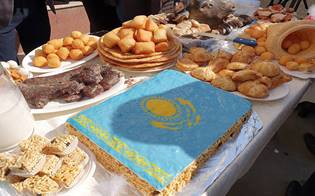
1. 1.Прочитайте и переведите текст на русский язык. Выполните задание по тексту.
In the Kazakh national cooking as in a mirror found reflections the people`s nature, its history, customs and traditions.
Since olden times hospitality has been the most distinctive feature of the Kazakh people. The dear guest was given a cordial welcome, he was offered the place of honour and entertained heartily.
In the first instance the guest was treated to kumys, shubat or airan, then to tea with milk or cream, baursaks, raisins, irimshik, kurt. Then followed appetizers made of horseflesh or mutton – kazy, shuzhuk, zhai, zhaya, sur-yet, karta, kabyrga. Flat cakes made of flour were served without fail.
The adornment of any dastarkhan and the most popular dish among the Kazakhs has always been meat in the Kazakh manner. Boiled meat was usually served in large pieces. The host cut the meat treating every guest to dainty pieces: the pelvic bones and shin were given to elderly guests of honour, the brisket – to the son-in-law or daughter-in-law, the cervical vertebra – to girls and so on. To the guest of honour ranking highest among the others the host handed over the sheep`s head cooked in a special way. The guest had to distribute it among those present observing a certain ritual which reflects the ancient custom of respectful regard for guests – old men, children, close and distant relatives.
The fragrant meat is eaten with rolled and boiled small pieces of dough. An excellent addition to this dish is the saturated fragrant meat broth called sorpa which is usually served in pialas. At the end of the meal kumys is served which is again followed by tea.
The present-day entertainment has changed in some details but continues to observe the ancient laws of hospitality. The present-day Kazakh cuisine includes not only traditional Kazakh dishes but also dishes of the Uzbek, Uigur, Russian, Tatar, Korean and other cuisines the Kazakh caught the fancy of.
In present-day cuisine the set of food-stuffs of which food is made has considerably changed.
If during its century-old history the Kazakh people have accumulated much experience in processing and cooking meat and milk dishes, the present-day life has replenished this set by dishes made of vegetables, fruits, fish, sea products, as well as baked and meal makings and sweets.
And nevertheless meat has been and remains the most popular food-stuff in the Kazakh national cuisine.
Meat is the basis of the majority of dishes: exactly meat dishes adorn any dastarkhan: their abundance is a sign of the festive table`s richness and diversity.
Since olden days the Kazakh cooking distinguishes itself by its peculiar technology. The peculiarity of the Kazakh people`s tenor of life left its mark on the ways of food making. In the traditional Kazakh cuisine preference was always given to boiling. Exactly the process makes it possible to obtain soft and delicate gustatory shades of meat, adds juiciness and fragrance to it.
Great importance was given to laying-in and long-term preservation of food. During live-stock slaughter a part of meat was salted, dried, sometimes smoked; of horse-meat mainly such delicacies as kazy, shuzhuk, zhai, zhaya, karta and so on were made.
Bread was baked mainly in form of flat cakes; among baked makings the greatest popularity enjoyed and enjoy baursaks.
Among drinks kumys, shubat and airan were always popular; tea enjoyed particular popularity.
Agree or disagree:
French cuisine

1.Прочитайте и переведите текст на русский язык. Выполните задание по тексту.
French cuisine is characterized by its extreme diversity. In that, it can only be compared to Chinese cuisine or the cuisine of India.
Traditionally, each region of France have their own distinctive cuisine: cuisine from northwest France uses butter, cream, and apples; Provençal cuisine (from the southeast) favors olive oil, herbs, and tomatoes; cuisine from southwest France uses duck fat, foiegras, porcini mushrooms (cèpes), and gizzards; cuisine from northeastern France is reminiscent of German cuisine and uses lard, sausages, beer and sauerkraut.
. Average French people do not eat or prepare this cuisine in their everyday life, and rather eat the regional cuisine of the region where they are located. Wine and cheese are an integral part of French cuisine (both Paris high cuisine and regional cuisines), both as ingredients and accompaniments. France is known for its large range of wines and cheeses.For French people, cooking is part of culture, and cooking and good food are well appreciated. The French generally take a high pride in the cuisine of their country, and some, particularly in the older generations, are reluctant to experiment with foreign dishes.
The normal meal schedule is to take a light breakfast in the morning (consisting of bread and/or cereal, possibly coffee and some fruit, perhaps croissants), a lunch at some point between noon and 2PM, and dinner in the evening. A normal complete meal consists in appetizers (perhaps raw vegetables or salad), a main dish (generally, meat or fish with a side of vegetables, pasta, rice or fries), some cheese and/or dessert (fruit or cake). With contemporary lifestyle, especially the reduced number of housewives, the French rely a lot more on canned or frozen foods for weekdays. Cooking evening or weekend meals from fresh ingredients is still popular. In most cities, there are street markets selling vegetables, meat and fish, several times a week; however, most of those products are now bought at hyper- or supermarkets.
Traditionally, France has been a culture of wine consumption. While this characteristic has lessened with time, even today, 98.67% of the French consume wine every day. Beer is especially popular with the youth. Schematically, French restaurant cuisine can be divided into:
Cuisine bourgeoise, which includes all the classic French dishes which are not (or no longer) specifically regional, and which have been adapted over the years to suit the taste of the affluent classes. This type of cooking includes the rich, cream-based sauces and somewhat complex cooking techniques that many people associate with French cuisine. At the ‘top end’ of this category is what is known as haute cuisine, a highly complex and refined approach to food preparation and kitchen management.Because this kind of cuisine is what is often served abroad under the name of “French cuisine”, many foreigners mistakenly believe that typical French meals involved complex cooking and rich, un-dietetic dishes. In fact, such cooking is generally reserved for special occasions, while typical meals are simpler.
Cuisine du terroir, which covers regional specialities with a strong focus on quality local produce and peasant tradition. Many dishes that fall in this category do not stand out as stereotypically “French,” sometimes because regional cooking styles can be quite different from the elaborate dishes seen in French restaurants around the world.
Cuisine nouvelle or nouvelle cuisine, which developed in the 1970sas a reaction to traditional cuisine, under the influence of chefs such as Michel Guérard. This type of cooking is characterized by shorter cooking times, much lighter sauces and dressings, and smaller portions presented in a refined, decorative manner. Its modern, inventive approach sometimes includes techniques and combinations from abroad (especially Asia) and has had a profound influence on cooking styles all over the world.
2. Ответьте на вопросы по тексту :
1. What does a normal complete meal consist of?
2. What is integral part of French cuisine?
3. What can French restaurant cuisine be divided into?
4. What sauces does cuisine bourgeoise include?
5. What is nouvelle cuisine characterized by?
6. What cuisine can French cuisine be compared to?
7. What cuisine uses duck fat, foiegras, porcini mushrooms (cèpes) and gizzards?
3. Переведите на английский язык следующие предложения:
1. Французскую кухню можно сравнить только с китайской кухней или кухней Индии.
2. Кухня северо-восточной Франции напоминает немецкую кухню и использует сало, колбасные изделия, пиво и квашеную капусту.
3. Франция известна своим большим ассортиментом вин и сыров.
4. В большинстве городов есть уличные рынки, продающие овощи, мясо и рыбу несколько раз в неделю.
5. Этот тип приготовления включает в себя богатые соусы на основе сливок и несколько сложных методов приготовления, которые многие люди связывают с французской кухней.
6. Кухня новелле характеризуется более коротким временем приготовления, гораздо более легкими соусами и заправками, а также меньшими порциями, представленными в изысканной, декоративной манере.
7. Французскую кухню ресторана можно разделить на буржуазную кухню, дю терруар и новелле.
Historical culinary traditions of Germany
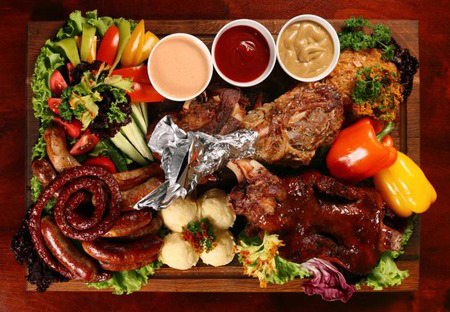
1.Прочитайте и переведите текст на русский язык. Выполните задание по тексту.
The main distinguishing feature of German cuisine is satiety. German cuisine cannot be called dietary. Almost all dishes are prepared exclusively by frying, stewing and baking methods. Germany has become famous all over the world for its love of numerous and diverse sausages, sausages, the number of traditional dishes of German cuisine includes more than three hundred of their types and, of course, beer. In addition to sausages, the traditional meat cuisine of Germany can include numerous varieties of cutlets, schnitzels, steaks and shnelklops. German cuisine has a huge number of regional dishes – Black Forest cake, Westphalian ham, Swabian dumplings, Bavarian fish soup with meatballs and pickles. A classic German breakfast necessarily includes boiled eggs, ham or sausage, bread and sandwiches with jam. Lunch consists of several dishes – soup, appetizers, main course and dessert. Lunch for Germans is the main time
he main meal. Soup is an integral part of this meal.. The most unusual German soups are beer and bread. Moreover, the meal is necessarily accompanied by sandwiches with cheese, fish or sausage products. In addition to soups, German cuisine contains a huge number of a wide variety of broths. The Germans use broth in different versions – with eggs, with dumplings, with vegetables or rice. The most unusual German soups are beer and bread. Fish occupies a special place in German cuisine, it is prepared not only as an independent dish, but also used to prepare salads, snacks, sandwiches. Vegetables in German cuisine are used for the preparation of almost all meat, first, main dishes, snacks and salads. The most common side dishes in Germany are boiled potatoes, carrots, cabbage, spinach, turnips For dinner, Germans eat mostly only cold dishes.
Task 1.
Factfile on______________________________food.
Typical meal: meze, dips, bread and a main course. Spices/souses/dips:___________________________________________________ Traditional cooking technique/pot: skewered meat, grilled on an open fire. Habits and customs:__________________________________________________________ Typical dishes:_____________________________________________________________ Typical drinks:______________________________________________________
Chinese food
1.Прочитайте и переведите текст на русский язык. Выполните задание по тексту.
Chinese food is famous all over the world, but you may be shocked by its surprising range and variety of ingredients if you’ve only eaten in Chinese restaurants abroad. Chinese food has countless delicious and fantastic dishes. And people from different areas have different cuisine types, which can be bland, sweet, salty, spicy, or sour.
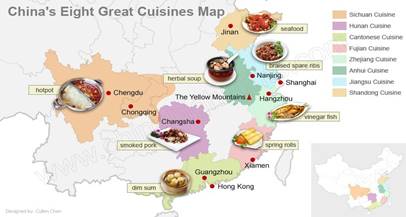 China’s Regional Food Types
China’s Regional Food Types
China can be divided into several regions with distinct styles of cooking. The ingredients used are based on the natural and agricultural products of each region.
Northern China food — salty, simple, less vegetables with wheat as the staple food. Food using wheat as its main ingredient, such as noodles and dumplings is prevalent there.
 Pickled cabbages
Pickled cabbages
Northerners tend to eat more (red) meat and dairy, as the calories, fat, and protein strengthen their bodies against the chilly weather.
Western China food — hearty halal food /сытная
There is no pork or carnivorous animals on the menu. Wheat is the main staple grain, and a few vegetables are grown there, mostly onions, carrots, peppers, eggplants, and tomatoes. Xinjiang is also famous for its fruit, particularly dried fruit.
Protein foods include mutton top of its ingredients list, beef, camel meat, horse meat, and various dairy foods.
Central China food — spicy with a lot of seasonings. It is characterized by lots of preserved foods, particularly pickled vegetables and tofu, which give it its sour flavor.
 Sichuan hotpot
Sichuan hotpot
Eastern China food — sweet and light. Eastern food features an abundant use of seafood, fish, pork, poultry, a wide variety of vegetables. Both rice and wheat are common staples.
 Sweet and sour fish
Sweet and sour fish
Southern minority food — sour, and many minorities eat chilies every day.
Southern ethnic food is typically simple and full of natural ingredients, with little wastage. Heads, feet, and innards are all eaten. Pickling in brine or vinegar, sun-drying, and curing were traditionally the only ways to preserve foods in the damp southern weather. The “mountain peoples” pickle vegetables, tofu, and chilies; smoke meat, poultry, fish, and tofu; and sun-dry fruits, fish, vegetables, and chilies.
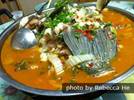 Guizhou sour fish
Guizhou sour fish
Tastes of Chinese food are traditionally categorized into five flavors: salty, spicy, sour, sweet, and bitter.
Chinese emphasize “he” harmony of five flavors. According to traditional Chinese medicine, the harmony of the five flavors can not only improve taste enjoyment, but also have the function of achieving balance to promote health, as well as treating diseases and aiding recovery from injury.
Chinese food has a distinctive culinary style all its own. The emphasis is on fresh, seasonal ingredients, prepared with a minimum of fuss and beautifully balanced for color, texture, and presentation.
Task 1. Questions for the text. (on the contrary)
What tastes can be Chinese food?
What are the main features of Northern China food ?
What are the main dishes of Western China food?
What products include protein?
What are the main dishes of Central China food?
How can you characterize dishes of Eastern China food ?
What are the main dishes of Southern minority food?
What five flavors of Chinese food are traditionally categorized into?
What do Chinese emphasize ?
What can food improve?
What way do Chinese cook?
Task 2. Заполните таблицу
Factfile on______________________________food.
Typical meal: meze, dips, bread and a main course. Spices/souses/dips:___________________________________________________ Traditional cooking technique/pot: skewered meat, grilled on an open fire. Habits and customs:__________________________________________________________ Typical dishes:_____________________________________________________________ Typical drinks:______________________________________________________
Task 3. Прочитайте письмо о китайской еде. Выполните просьбу китайского друга.
Dear friend,
You asked me to tell you what we eat and drink here in China. Well, for breakfast I usually have green tea and rice porridge.
For lunch I have rice and vegetables and more tea, and for dinner I have rice again, usually with some pork or chicken, I usually drink tea-again! And we finish the meal with some soup. 0n special occasions we have duck or fish for dinner – I like duck, but I don't like fish very much-and in the summer we often eat fruit, like mangoes or peaches or melons. I love mangoes! At Chine’s New Year we have my favourite meal dumplings?!
Please write and tell me about food in your country,
Song Lin.
FOODS OF THE JAPANESE
1.Прочитайте и переведите текст на русский язык. Выполните задание по тексту.
Japan accounts for about 8 percent of all the fish caught in the world. Each person in Japan eats more than 150 pounds of fish per year, or around three pounds of fish per week.
Rice and noodles are the two primary staples of the Japanese diet. Rice, either boiled or steamed, is served at every meal. Noodles come in many varieties. Among the most popular are:
Ramen – thin, curly noodles, also made from wheat flour (egg noodles with soup, vegetables and meat or fish)
Udon – thick white
noodles made from wheat flour . (Thick noodles with soup that can be with tofu,
meat or vegetables. For the hot dish, noodles and soup are usually served
together in the same bowl. For the cold dish, noodles and soup are usually
served in different dishes)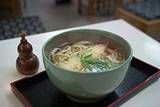
Soba – thin brown
noodles made from buckwheat flour. (Thin noodles
with soy-sause-based soup. In hot dishes, noodles and soup are
usually served together in the same bowl. For cold dishes, the
noodles and soup are usually served in different bowls).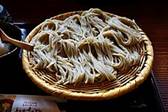
Noodles (like in most Asian foods) are used often in Japanese foods. The dishes usually come originally from China; nevertheless they have reached a unique development in Japan.
Soy sauce and other soybean products are also staples in Japan. These include miso (fermented soybean paste) and tofu (a soybean curd that resembles custard).
Soya beans are a very important ingredient in Japanese cooking; it is used in soya sauce, miso and tofu. Soya milk is also used as a drink. One example of a dish with soya beans in it, is tofu. Tofu is made from pressing soybeans into cubes and then boiling them. Tofu is often in soups and stews. Deep fried tofu is also used in many popular Japanese dishes, for example as kitsune udon and inari sushi. Soya beans also have omega 3 fatty acids, that can also be found in salmon.
Other common ingredients in Japanese food include bamboo shoots, daikon (a giant white radish), ginger, seaweed, and sesame seed products.
Japanese pickles called tsukemono are served at every meal. Seafood is also plentiful in this island nation.
Green tea is the national beverage of Japan, although black tea is also available. Sake (SAH-kee, wine made from rice, usually served warm) and beer are also very popular.
Two uniquely Japanese foods are sushi (fresh raw seafood with rice) and sashimi (fresh raw seafood with soy sauce); both rely on freshly caught fish or seafood. Dishes prepared in a single pot ( nabemeno ) are popular throughout Japan.
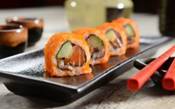
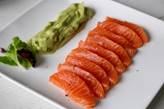
Wasabi is a spice traditionally
prepared from a plant from the cabbage family. Its root is
used as a spice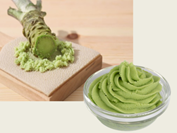
and has a very strong flavor. The root is smashed up into paste and used as a condiment. Its hotness is more like hot mustard or horseradish than chili pepper, because it irritates the nose more than the tongue. Eating too much wasabi can cause a very painful feeling in the nose. It is often eaten with sushi.
Sukiyaki is a dish made up of paper-thin slices of beef (or sometimes chicken), vegetables, and cubes of tofu cooked in broth.
Shabu-shabu is beef and vegetables, also cooked in broth but then dipped in flavorful sauces.
Each region has its own selection of favorite foods. People living on the cold northern island of Hokkaido enjoy potatoes, corn, and barbecued meats. Foods in western Japan tend to be more delicately flavored than those in the east.
The Japanese are known for using very fresh ingredients in their cooking. They prefer using fresh, seasonal foods for their meals, buying it the same day it will be cooked. The Japanese are also famous for their skill in arranging food so that it looks beautiful. The people of Japan live long lives and have a low rate of heart disease because of healthy eating habits.
Questions for the text.
How much fish does each person in Japan eat per year?
What are the two primary staples of the Japanese diet?
What types of noodles are there?
What is made of soya beans?
What is tofu?
What other common ingredients are in Japanese food?
What are the national beverages of Japan?
What is sushi?
What is sashimi?
What is Wasabi?
What are others Japanese dishes?
Translate the recipe.
Gohan (Boiled Rice)
Ingredients
I. cup Japanese short-grain rice, uncooked (available at most supermarkets and Asian food stores)
1¼ cups water
Procedure
Wash the rice and allow it to soak in a saucepan for about 30 minutes; let drain.
Return the rice to the saucepan, add water, and bring to a boil over high heat.
Reduce heat, cover, and let simmer, cooking about 15 minutes more until water has been absorbed by the rice.
Reduce the heat to medium and keep covered, allowing rice to steam for about 15 minutes.
Serve in individual bowls with chopsticks (optional).
Serves . To eat rice, the rice bowl is held in the left hand, close to the mouth. The chopsticks are used to push the rice into the mouth as the bowl is slowly rotated in the hand.
Turkish cuisine
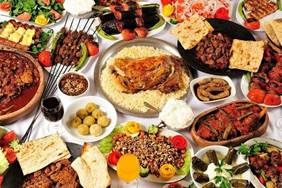
1.Прочитайте и переведите текст на русский язык. Выполните задание по тексту.
Turkish cuisine has something for every taste, from sweet Baklava and rich yogurt to amazing pickles and Turkish coffee.
The better-known meat dishes come in different styles depending on the region of origin: the spicy Adana; the mellow Urfa; the Antep, sandwiched between thick eggplant slices; a simple dürüm wrap in thin unleavened lavaş bread. The most famous is the İskender kebap, where razor-thin slices of lamb are smothered in yogurt, tomato sauce, and butter.
Turks adore their yogurt, they use yogurt in combination with salty dishes. It is denser and has a touch of acidity. Do not be surprised to find some next to your meat and your vegetables. A favorite beverage is the cool, salty ayran.
The Turkish breakfast is usually oven-fresh bread accompanied by honey and Turkish clotted cream (or kaymak), preserves like rose and fig marmalade, sheeps’ milk cheeses, and tomatoes and cucumbers drizzled in olive oil are standard fare, but every region has its own specialties. You have to try the menemen: runny scrambled eggs cooked with onions, green peppers, and tomatoes.
Rose. Its petals also make incredible marmalade or can be infused in apple vinegar and olive oil.
Baklava. This dessert is the sweet stacks of fine filo pastry,
drenched in milky honey and covered in pistachio nuts.
Nuts and fruit. Figs, cherries, strawberries, peaches, melons, watermelons, mandarin oranges, apples, chestnuts, walnuts, pistachios, olives, lentils, chickpeas, green beans, peppers, tomatoes, cucumbers, eggplant, beets, and honey.
Pide. Dubbed “Turkish pizza,” pide is
flatbread baked in a wood-fired oven. It comes with a variety of meaty
toppings: sucuk (Turkish sausage), pastrami, and minced (kıyma)
or chopped (kuşbaşı) lamb meat are popular offerings.
Cheese and veggies are also utilized. Some restaurants will break an egg on top
of your pide when they take it out the oven, which keeps
everything super succulent.
Turks will pickle just about anything. Eggplants, tomatoes, cabbage, plums — there are even reports of pine cones — they all get immersed in tart vinegar.
Turkish ice cream is like no other you’ve had. It has the distinctly smoky taste of natural mastic. The thickness comes from salep, made from the root of the Orchis mascula.
In almost every country, from Poland to Japan, there’s a version of meat wrapped in steamed dough. The Italians call it ravioli, the Georgians eat khinkali, and Turks tuck into plates of mantı. This version of dumplings is served with dollops of fresh, tart yogurt, doused with melted butter, and sprinkled with chopped herbs and chili flakes. It’s as tasty as it sounds.
Turkish dolma is a dish
where rice and meat gets stuffed into hollowed-out peppers, tomatoes, zucchini,
or dried eggplants, then slowly braised. Sarma sees the same
ingredients rolled in vine or cabbage leaves.
Turks have very sweet teeth, and sugared chestnuts,
or kestane şekeri, are just one of a plethora of candied
fruits, vegetables — even nuts with their shells still on — you’ll find
here. 
The dessert is tavuk göğsü, or chicken breast pudding. This strange-seeming blend of boiled chicken, milk, and sugar that’s been dusted with cinnamon is — perhaps surprisingly — delicious. Pictured above is the caramelized version, called kazandibi.
Task 2/
Find the synonyms: pickled – spicy, unbelievable – incredible, mixed – scrambled, minced meat – ground meat, juicy – mellow, succulent, abundance – plethora [ˈpleθərə] избыток, изобилие,, thick – dense, tasty – delicious, filled – stuffed, sliced – razor-thin, rolled – wrapped, dollops – spoons.
b) Name
Task 3.Answer the questions.
What have you known about the Turkish cuisine?
What types of dishes do you prefer?
Task 4. Заполните таблицу
Factfile on______________________________food.
Typical meal: meze, dips, bread and a main course. Spices/souses/dips:___________________________________________________ Traditional cooking technique/pot: skewered meat, grilled on an open fire. Habits and customs:__________________________________________________________ Typical dishes:_____________________________________________________________ Typical drinks:______________________________________________________
Ukraine
Прочитайте и переведите текст, выполните задания.
Ukraine is the second largest country in Europe. Being situated between Russia and Poland, it is known for its rich soil and favorable climate.
Ukrainians like to cook and eat tasty, homemade food. From old times they grew barley, rye and wheat. They also herded cattle, pigs and sheep. It is well reflected in national cuisine and traditions. For example, bread and wheat products are very important for local people. On special occasions people cook korovai, paska or kalach. Korovai is usually served at weddings. Kalach is similar to korovai but is baked for Christmas. Its three strands represent the Holy Trinity. Paska is baked for Easter. Its main ingredients are milk, butter, eggs, sugar, flour and raisins.
There are many delicious soups in Ukrainian cuisine, but perhaps the most famous of all is borscht – a cabbage soup with beets, carrots and other vegetables. Every cook has his own recipe of borscht. Main course is rather versatile. Ukrainians like treating their guests with varenyky – stuffed dumplings with mashed potato, cheese or cherries, depending on one’s taste.
Every Ukrainian house can offer you salo. This delicious food consisting of cured slabs of fatback has become really popular, so nobody leaves Ukraine without trying it. For the dessert you can try syrniki – fried quark pancakes served with jam, honey and sour cream.
There are thousands of other nourishing and tasty dishes in Ukraine. Perhaps, cuisine is the first thing people notice, when visiting this country.
Task2/ Agree or disagree:
1. Ukrainians do not like to cook and eat tasty. homemade food.
2. There are many delicious soups in Ukrainian cuisine.
3. They do not like salo.
4. Kalach is baked for weddings
Task 3. Translate sentences
1.Украинцы любят угощать гостей варениками.
2. У каждого повара есть свой рецепт борща.
3. На десерт они едят сырники.
4.Калачи пекутся на Рождество
Greece
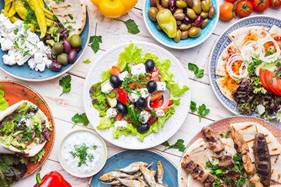
Прочитайте и переведите текст, выполните задания.
The Greeks have Mediterranean eating habits with a diet of fresh fruit, vegetables, meat, fish, cheese and olive oil. The herbs and spices used are oregano, mint, garlic, onion, dill and bay leaves. Lunch is the main meal with meze, traditional Greek starters like grilled octopus, olives, aubergine or goat’s cheese salad. Food is usually served with bread and dips such as taramosalata, made of fish roe, or tzatziki, made of yoghurt and cucumber and accompanied with a glass of red wine. This is followed by main courses such as moussaka, made with aubergines, lamb and cheese, or souvlaki, skewered meat cooked in a traditional way, grilled on an open fire. Other cooking techniques include frying, sturias, boiling, baking and roasting.
2. Заполните таблицу
Factfile on______________________________food.
Typical meal: meze, dips, bread and a main course. Spices/souses/dips:___________________________________________________ Traditional cooking technique/pot: skewered meat, grilled on an open fire. Habits and customs:__________________________________________________________ Typical dishes:_____________________________________________________________ Typical drinks:______________________________________________________
Mexico
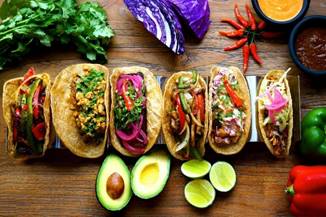
/Прочитайте и переведите текст, выполните задания.
Mexicans love to eat together.
Traditional Mexican cuisine is hot and spicy, with chilli and garlic and herbs like oregano. A central ingredient is corn to make tortilla, a type of flatbread. Tortillas can be fried and filled with meat, fish, vegetables, beans and cheese to make enchiladas. They are often served with a spicy tomato sauce called salsa, sour cream, or an avocado dip called guacamole. Mexicans also eat a lot of rice and sweet potatoes and it is the birthplace of chocolate! Mexican beers and fresh fruit juices are popular drinks. Cooking methods include grilling, frying and boiling, but they also have a more traditional technique of slow cooking marinated meat over an open fire known as barbacoa. It is easy to see where the word ‘ barbecue’ came from.
2 Заполните таблицу.
Factfile on______________________________food. Typical meal: __________________________________ Spices/souses/dips:_______________________________ Traditional cooking technique/pot: barbacoa. Habits and customs:________________________________ Typical dishes: enchilada. Typical drinks:____________________________________
India
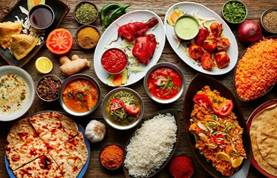
/Прочитайте и переведите текст, выполните задания.
Indian meals are based on rice and curry, a dish of meat, fish or vegetables cooked in a spicy sauce. Common spices are chilli, cumin , turmeric, ginger, coriander and garlic, while dips include mango chutney, lime pickle and raita , made of yoghurt and cucumber. There are many vegetarian dishes too, because Hindus, the main religious group in India, do not usually eat meat. Indian food is traditionally eaten by hand and accompanied by different kinds of flatbread such as naan, baked in a tandoori , a traditional hot clay oven, where you also cook the famous dish, tandoori chicken. Indians love drinking masala chai: tea leaves, spices and milk boiled together to make a very sweet drink. Lassi is also a popular drink, combining yoghurt, milk , fruit and spices.
2 Заполните пропуски.
Factfile on______________________________food. Typical meal: ____________________________________________________________. Spices/souses/dips: _____________________________________________ Traditional cooking technique/pot: ___________________________________ Habits and customs: .
Typical dishes:
Typical drinks:
Task «Read and translate professional texts»

1.Mongolia
The most common rural dish is cooked mutton, often without any other ingredients. In the city, every other local displays a sign saying «buuz». Those are steamed dumplings filled with meat. Other types of dumplings are boiled in water (manti), or deep fried in mutton fat (khuushuur). Other dishes combine the meat with rice or fresh noodles made into various stews or noodle soups. The most surprising cooking method is only used on special occasions. In this case, the meat (often together with vegetables) gets cooked with the help of stones, which have been preheated in a fire. This either happens with chunks of mutton in a sealed milk can (khorkhog), or within the abdominal cavity of a deboned goat or marmot (boodog).
2.Iceland and Greenland
Iceland and Greenland are not just places to brave the cold and the dark in, but also they test your stomach strength by offering the dish called Hákarl – fermented shark.
It’s cured for months by being buried under sand and when it’s good and rotten, it is strung up to dry out for a few months more. It is said to have an overpowering, gagprovoking ammonia smell and the real challenge is keeping it down after the stink of it has bowled you over. But if you can consume a piece of rotten shark without bringing it back up again, then you’ve the strength and bravery of a Viking!
3.Tanzania / Kenya
In some parts of Africa drinking animal blood is a tradition. It comes down generations from when people would have walked at great lengths across a desert, drinking animal’s blood was thought to give the traveler strength and stamina. The Masai people drink animal’s blood to celebrate the birth of a child as well as consuming it as part of their regular diet. If you’re in Africa and happen upon some cow’s blood (naturally of course) then mix it with some milk and pour it into your scrambled eggs or fry it with rice.
4.Lithuania
Lithuanian food is heavily based upon root vegetables (e.g., potatoes and beetroot), meat, and dairy products, which can all be grown in Lithuania’s cold climate. Filling, hearty, and meant to keep you warm from the inside, Lithuanian food is certainly something worth trying. Here is traditional Lithuanian dish that have been passed down from grandparent to grandchild for centuries. Chilled Borscht (Saltibarsciai). Served seasonally, this beetroot and kefir soup is accompanied by hardboiled eggs and boiled potatoes. Notably, chilled borscht is a shocking color of bright pink and is an indicator that warm weather has arrived in Lithuania.
5. Bolivia
A mixture of lamb and beef meat cooked slowly – bones and all – until tender, and served with what look like mashed potatoes, but are really mashed Lima beans, green peas, white corn and potatoes. A lot of flavor goes into both the meat and veggie mash with hefty amounts of chili, cayenne pepper, cumin, oregano, and mint. This is such a great dish, but is hard to find outside of Bolivia.
6.Southeast Asia
The Philippines, Thailand and Cambodia have got a few things on their menus that aren’t for the faint-hearted. Arachnophobes, steer clear of the fried spiders! These are a regional delicacy in the town of Skuon in Cambodia and these species of tarantula are the size of a human palm. Although the taste of them has been described as bland, it’s the contents of the abdomen that might be worth having second thoughts over, you’d basically be eating a spider’s eggs and guts
Around Europe
1.AUSTRIA
Soups are generally substantial particularly when served with dumplings such as leberknodelsuppe (liver dumplings in beef broth). The most popular meats are veal (Wiener Schnitzel) and pork which is often served roasted. There are various varieties of sausages usually flavoured with garlic. Austria is world famous for its confectionery, cakes, flans and tarts like apfelstrudel and chocolate sachertorte which are often very rich and served with cream.
2.BELGIUM
Cafes serve rich and satisfying soups with sandwiches. A great deal of meat is eaten especially beefsteak, pork and veal. Beer is often used in cooking, for example in carbonnades flamandes which is collar of beef and onions braised in beer. A typical dish is waterzooi, a chicken and vegetable stew served with boiled potatoes. Chicory is a popular vegetable and is often served as a main dish, or eaten raw in a salad. Typical seafood includes mussels, shrimps and especially eels. Pickled eels fried in oil and served cold with jelly are a delight.
3.CZECHOSLOVAKIA
A square meal offered to the foreign visitor starts off with assorted cold meats, famous Prague ham, smoked tongue, Russian crab meat in mayonnaise, eggs with caviar, all garnished with plenty of pickles. Roast pork, duck and goose as well as meat with a thick gravy are often accompanied by the beloved knedliky dumplings and zeli, spiced red cabbage.
3. DENMARK
The great speciality is the smorrebrod, an open sandwich of endless variety usually based on rye bread, with such ingredients as herring; fried eel, ham and shrimps. These are followed by hot dishes including fried fish, especially plaice, served with a sauce or rissoles. Danish pastries are very varied and there is a famous dessert called rodgrod medflode, jelly of redcurrants and other fruits served with cream.
5.HUNGARY
One of the few original cuisines in Europe. Paprika dishes come in a great variety. The six basic dishes are gulyas, a soup with cubed beef and diced potatoes spiced with sweet red paprika; pOrkolt pork, veal, beef or chicken stew; sturia, a meat fricassee sprinkled with sour cream; tokdny, a beef stew with black pepper flavouring; rostelyos, stewed sirloin cutlet in paprika sauce and finally halaszle, Hungary’s fish soup answer to bouillabaisse. Retes, a flaky pastry comes filled with cherries, apple, nuts, almonds, poppy-seed or cottage cheese.
6.LUXEMBOURG
The country enjoys a good reputation for its cuisine. Among the national dishes are: Treipen (Black Pudding) and sausages with horseradish; smoked pork and broad beans; jellied suckling pig; calf’s liver quenelles (forcemeat) and delicious Ardennes ham, served raw or cooked. Trout and pike are excellent and during the shooting season jugged hare is a favourite.
7.NETHERLANDS
Breakfast usually consist of thinly sliced Dutch cheese, prepared meat and sausage served with several varieties of bread. A typical lunch is koffietafel, bread, various cold meats, cheeses and conserves served with a side dish, either omelette or salad. Some of the national dishes include erwtensoep, rich pea soup and boerenkool met rookwoorst, curly cabbage with smoked sausage. Rijsstafel is a dish which reflects its Indonesian origin by including boiled rice, chicken, shrimps, small red fish and fried fruit. Cheeses are varied and include Gouda and Edam.
8.NORWAY
Lunch consists of smorbrod (open sandwiches) or koldtbord (ample cold buffet), famous for its variety of dishes including smoked salmon, fresh lobster and shrimps. Some specialities are fiskeboller (fish rissoles) gravlaks (fish pudding and salmon). Game including ptarmigan and dyrestek (reindeer) are in season at certain times of the year.
9.POLAND
Barszcz, a beetroot soup served in large helpings along with sausage, cabbage, potatoes, sour cream and czarny chleb (coarse rye bread) is a favourite. Chlodnik is a cold rich cream soup with crayfish. It is worth trying flaki, a dish of tripe served boiled or fried and bigos, sauerkraut with smoked meats. Hare cooked in cream, roast venison and smoked ham or pork loin are regular meat dishes.
10.PORTUGAL
There is a wealth of sea food available. Many are based on bacalhau (cod), fresh or salted, tunny, mackerel, sardines and lagosta (crayfish). Gaspacho is an iced soup of bread, tomatoes, onions garlic, cucumber and pimentos. Of the meats, pork is best. It can be roast or grilled and it features in some fish dishes, for example, Consoada, baked cod with peas, fried pork and fritters. I caramel and rice pudding with cinnamon are popular. Crystallized fruits and sugar plums are worth trying.
11.SPAIN
Much of the cooking is done in olive oil and rice figures in many of the national dishes such as paella (rice with chicken, fish and vegetables). Tortillas (omelettes) are also popular. Stews are varied and include Fabada, haricot beans, bacon and sausage. One of the best known sweets is turrdn de almendras, made of almonds, egg whites and sugar. There is a variety of cheeses from the soft getilla to the smoked sturias and manchego made from ewe’s milk.
12.SWEDEN
Smorgasbord, a kind of extensive hors d’oeuvre of pickled or smoked herring, liver pate, sausage, smoked salmon, sliced meats, salads and cheeses. Popular dishes also include meatballs, several varieties of sausage and kaldolmar (minced meat and rice baked in cabbage leaves). Also crayfish, lobster and many kinds of game such as venison and moose meat.
13.SWITZERLAND
The most famous dish of Swiss origin is fondue (melted cheese with white wine and kirsch added, into which bread is dipped). Pork and veal form the basis of most meat dishes and trout, perch and pike, fresh from the mountain steams and lakes are very good. Gruyere and Emmenthal are probably the best-known cheeses.
14.YUGOSLAVIA
Yugoslav cuisine incorporates features of both European and Oriental cookery. Tea is served with lemon or rum. Coffee is normally black. Among meat dishes as cevap, large pieces of highly spiced pork; podvarak, various kinds of meat with sliced sour cabbage and kapatna, braised lamb always served with spinach. Halva pastry stuffed with chopped walnuts and honey is also a well-known sweetmeat.
Practice
II. Fill in the table using information about a brief description of the cuisine of different countries
|
№ |
Country |
Brief description of the kitchen |
The main dishes of the country |
|
|
|
|
|
|
|
|
|
|
|
|
|
|
|
|
|
|
|
|
|
|
|
|
|
|
|
|
|
|
|
|
|
|
|
|
|
|
|
|
|
|
|
|
|
|
|
|
|
|
|
|
|
|
|
|
|
|
|
|
|
|
|
|
|
Task. 3.According to the descriptions of food given for each country, match the specialities on the left with the countries on the right.
1. Seafood sandwiches
2. Paprika dishes
3. Pork dishes
4. Cheese fondue
5. Bliny
6. Pasta dishes
7. Bouillabaisse
8. Pastries and tarts
9. Stuffed vine leaves
A. Hungary
B. Greece
C. Russia
D. Italy
E. Portugal
F. Austria
G. Spain
H. Denmark
I. France Unit 2
Recipes of dishes
Прочитайте и переведите рецепты блюд.
Fresh Cabbage Shchee (for four litres)
Beef or pork - one kilo with bone
Fresh cabbage - one kilo
Brown onions - 150 grams
Fresh tomatoes - 2 pieces or one spoonful of tomato paste
Root celery - one piece
Root parsley - one piece
Bay leaf - two pieces
Some dill and spring onions
Salt (to taste)
Water - four litres
The meat is boiled till it's half ready (for an hour or two). Then you put schredded fresh cabbage. Sliced brown onions, carrots, tomatoes, root celery and parsley are fried for twenty - twenty-five minutes in the frying-pan and put in the saucepan. Bay leaf is put at the end of cooking and should be taken away after shchee is ready. Shchee is served with sour cream, cut small spring onions and dill. Cooking-time - about three hours.
Sauerkraut Shchee
Sauerkraut is washed and stewed for an hour in the frying-pan. You can use butter or some fat. Meat is boiled in the saucepan. After an hour sauerkraut is simmered with meat. If you like you can put a potato or two ten minutes before putting the sauerkraut. Otherwise the potato(es) will taste badly. Fried vegetables: brown onions, tomatoes or tomato paste, carrots and greens: celery, parsley and bay leaf are put in the saucepan. Everything is simmered for half an hour. Sauerkraut shchee is served with thick sour cream, cut dill and parsley. Cooking-time is about three hours. Sauerkraut shchee is an old Russian dish.
Okroshka
(four - five portions) Kvas - 1 litre
New cucumber(s) - 1 of medium size
Spring onions - 100 gr
Hard-boiled eggs - 2
Boiled beef- 100 gr or boiled sausage/sausages
Lean ham - 50 gr
Spring onions and cucumber(s) are washed and sliced. So is boiled beef and ham. Hard-boiled eggs are cut large. All this is put in the kvas, salted to taste. It's better to have kvas sour. If it's sweet you can put a slice of lemon or citric acid at the tip of the knife. In home-made cooking a potato (boiled and cut) is added. Before serving okroshka it's recommended to keep it in a cool place or refrigerator for two hours. Okroshka is served with thick sour cream, cut parsley and dill. If it's too thick you should add some more kvas.
Chahohbily of Chicken
Chicken - 1 kg
Brown onions - 4 bulbs
Butter - 2 - 3 spoonfuls
Tomatoes - 800 gr
Kinza - 3 - 5 twigs
Black pepper, salt to taste
The salty chicken is cut and roasted in a sauce-pot. Shredded onions, fresh sliced tomatoes, pepper, cut greens - kinza, parsley, dill are stewed with the chicken. You can add a bay leaf and some allspice at the end of cooking. Ghahohbily is garnished with greens. Cooking-time is an hour.
Chicken "Tabaka"
Chicken "Tabaka" is roasted under press for an hour. Before roasting the chicken is greased with the prepared mass of pounded garlic (2-3 cloves), ground pepper, cut greens and salt. Chicken "Tabaka" is served on a large plate and garnished with chipped potatoes, marinated onions, tomatoes or cucumbers, raw or pickled. Tomato or pomegranate sauce is served separately. Cooking-time is an hour.
Satsivy of Poultry
Chicken-800 gr (or: turkey; duck; goose)
Butter-400 gr
The sauce: (Satsivy)
flour-25 gr
butter - 40 gr
kinza - some twigs
khmeli-suneli - a pinch
ground clove, ground saffron, cinnamon, cayenne, vinegar, salt to taste
two egg yolks
shelled walnuts-250 gr
brown onions - 120 gr
The prepared poultry is boiled whole till it's half ready. Then the poultry is greased with butter or fat and roasted in the oven. While roasting you should pour it with satsivy sauce and turn it over to get the poultry rosy from all sides. The satsivy sauce is made from the sliced brown onions slightly fried in the frying-pan, the flour diluted with some clear soup, pounded garlic, some vinegar, khmeli-suneli, clove, cinnamon and chopped greens. The poultry is put in this sauce and simmered for ten minutes. The shelled walnuts are chopped with some cayenne, yolk and saffron. The saffron in diluted in the clear soup (one pinch for 25-30 grams of clear soup). All this is added to the poultry but after that satsivy must not be boiled. The dish is sprinkled with nut oil and served cooled.
Muffins
(Ingredients):
· 1 cup milk. 1 стакан молока
· 2 tablespoons white sugar. 2 столовые ложки белого сахара
· 1 (.25 ounce) package active dry yeast. 1 (.25 унция) пакет активных сухих дрожжей
· 1 cup warm water (110 degrees F/45 degrees C). 1 чашка теплой воды (110 градусов F / 45 градусов C)
· 1/4 cup melted shortening. 1/4 стакана растопленного шортенинга
· 6 cups all-purpose flour1 teaspoon salt. 6 чашек универсальной муки1 чайная ложка соли
(Instructions):
1. Warm the milk in a small saucepan until it bubbles, then remove from heat. Mix in the sugar, stirring until dissolved. Let cool until lukewarm. In a small bowl, dissolve yeast in warm water. Let stand until creamy, about 10 minutes.
2. In a large bowl, combine the milk, yeast mixture, shortening and 3 cups flour. Beat until smooth. Add salt and rest of flour, or enough to make a soft dough. Knead. Place in greased bowl, cover, and let rise.
3. Punch down. Roll out to about 1/2 inch thick. Cut rounds with biscuit cutter, drinking glass, or empty tuna can. Sprinkle waxed paper with cornmeal and set the rounds on this to rise. Dust tops of muffins with cornmeal also. Cover and let rise 1/2 hour.
4. Heat greased griddle. Cook muffins on griddle about 10 minutes on each side on medium heat. Keep baked muffins in a warm oven until all have been cooked. Allow to cool and place in plastic bags for storage. To use, split and toast. Great with orange butter, or cream cheese and jam.
Potato pancake
Ингредиенты (Ingredients):
· 2 medium potatoes, peeled.
· 1 egg.
· 1/3 cup chopped onion
· 1 tablespoon all-purpose flour.
· 1/2 teaspoon salt.
· 1/4 teaspoon pepper.
· 1/4 teaspoon garlic powder.
· Canola oil.
1. Finely grate potatoes; drain any liquid. Place potatoes in a large bowl. Add egg, onion, flour, salt, pepper and garlic powder; mix well.
2. In a large skillet, heat 1/8 in. of oil over medium heat. Drop batter by 1/4 cupfuls; press lightly to flatten. Fry until golden brown on both sides. Serve immediately.
Pilaf
Ingredients
· 2⅔ c. low-sodium chicken broth
· ⅓ c. unsalted butter.
· 1 tsp. kosher sea salt. 1 ч. ложка
· ½ tsp. garlic powder.
· ¼ tsp. ground black pepper.
· ⅛ tsp. paprika.
· pinch onion powder
· 2 tbsp. olive oil.
· ⅓ c. vermicelli or orzo.
· 1 c. long-grain white rice.
· 1 tbsp. chopped fresh parsley.
Instructions:
1. In a medium saucepan set over medium heat, add the chicken broth, butter, salt, garlic powder, pepper, paprika, and onion powder. Once the mixture starts to simmer, reduce to low heat.
2. In a large skillet set over medium-low heat, add the olive oil. When the oil is hot, add the vermicelli and cook until brown, about 4-6 minutes. Add the rice and cook until it turns bright white, about 5-7 minutes.
3. Pour the warm broth mixture into the skillet, stir to combine. Once the mixture simmers, cover and cook for 15 minutes. Remove the cover, add the parsley, cover and continue cooking for 5 minutes or until all of the broth is absorbed. Serve immediately.
Pasta
Ingredients:
· 8 oz. bowtie pasta.
· salt for pasta water.
· 3 cups fresh spinach.
· 1 pint grape tomatoes.
· 8 oz. mozzarella.
PARMESAN BALSAMIC VINAIGRETTE:
· 1/3 cup olive oil.
· 3 Tbsp balsamic vinegar.
· 2 Tbsp mayonnaise. .
· 2 Tbsp grated Parmesan.
· 1/2 Tbsp Dijon mustard.
· 1 clove garlic, minced.
· 1/2 tsp dried basil.
· 1/4 tsp salt.
· freshly cracked pepper..
Instructions:
1. Fill a pot with water and add two large pinches of salt. Cover the pot and bring it to a boil over high heat. Once boiling, add the pasta and continue to boil until the pasta is tender. Drain the pasta in a colander, give it a brief rinse with cool water, and let it drain well while you prepare the rest of the salad.
2. While waiting for the pasta to cook, prepare the rest of the salad. Start with the Parmesan Balsamic Vinaigrette. Combine all the dressing ingredients in a jar or blender. Either blend until combined or shake your jar until the ingredients are well combined. Set the dressing aside until needed.
3. Roughly chop the spinach and slice the grape tomatoes in half. Dice the mozzarella into 1/2-inch cubes.
4. Add the spinach, tomatoes, and mozzarella to a large bowl. Once the pasta is well drained and mostly cool, add it to the bowl with the mozzarella and vegetables. Make sure the pasta is no longer hot, so it doesn’t wilt the spinach or melt the cheese.
5. Toss the ingredients to combine. If serving the salad later, store it like this without dressing. If serving immediately, add half of the dressing and toss to coat. Add more dressing as desired.
Fruit cake
Ingredients:
· 1 teaspoon baking soda.
· 1 cup sour cream.
· 1 cup chopped dates.
· 2 cups raisins.
· 1/2 cup chopped glazed cherries (can sub dried sweetened cranberries).
· 1 cup chopped walnuts.
· 2 cups all-purpose flour (divided into 1/4 cup and 1 3/4 cups).
· 1/2 cup butter (1 stick). )
· 1 cup granulated sugar.
· 1 egg, room temperature.
· Grated rind of one orange.
· 1 teaspoon salt.
·
Instructions:
1 Preheat oven, prepare loaf pan: Preheat oven to 325°F. Line a 9×5-inch loaf pan with greased parchment paper or brown baking paper, cut to fit the pan. Place one piece to run the length of the pan and stand up above the rim about an inch. Place the other piece or pieces to cover the other sides.
2 Mix together sour cream and baking soda: In a small bowl, mix together the baking soda and sour cream; set aside.
3 Toss dates, raisins, cherries with flour: Combine the dates, raisins, cherries, and nuts with 1/4 cup of the flour and toss to coat the fruit and nuts. Set aside.
4 Beat butter and sugar, add egg, orange rind, sour cream and baking soda, add flour and salt, add fruit and nuts: Beat together the butter and sugar until fluffy. Mix in the egg, then the orange rind, then the sour cream/baking soda mix. Add the flour and the salt and mix together. Combine fruit/nut mixture with creamed ingredients and mix well to distribute the fruit and nuts evenly.
5 Pour batter into baking pan and bake: Pour batter into a prepared 5×9-inch loaf pan.
Place the batter filled pan into the preheated oven. Place a separate pan of water in the oven either on a rack underneath the fruitcake or beside it. (The water will help with a more even, gentle cooking. Bake at 325°F for one and a half to two hours or until a wooden skewer inserted into the center comes out clean. Water may need to be replenished during baking.
6 Cool on a rack: Remove to a rack to cool for 5 minutes. Use the edges of the parchment paper to lift the cake out of the pan. Let cool completely. Wrap tightly with plastic wrap and then aluminum to store. If you want, you can sprinkle on a few ounces of brandy or bourbon, especially if you would like to store the fruit cake for a while.
Stuffed Chicken
INGREDIENTS : 1chicken weighing 1 kg 400 with liver,200 g button mushrooms, 3 stalks parsley,60 g butter, 20 g bread , 700 g potatoes, salt, pepper
1. Clean and wash the mushrooms. Wash and dry parsley and remove leaves. Mince the chicken liver, parsley, chopped mushrooms and bread.
2. Preheat the oven at 220°C. Melt 15 g of butter in a frying pan and fry the stuffing for 2 minutes on a moderate heat.
3. Add salt and pepper and leave to cool.
4. Once the stuffing has cooled, stuff the chicken and sew it up (or plug with a ball of greaseproof paper).
5. Put the chicken in an oven dish, coat it with 15 g of butter and put in the oven. Cook for 15 minutes.
Pizza
Ingredients:
Dough:
1 package active dry yeast (about 2 teaspoons)
1 cup warm water
1 teaspoon sugar
2 tablespoons olive oil
2 1/2 cups all-purpose flour
pinch salt
Topping:
1 can (8 ounces) tomato sauce
browned ground beef
1 can sliced mushrooms (drained)
thinly sliced green pepper and onions
1/2 cup grated Parmesan cheese
1 to 2 cups shredded Mozzarella cheese
1. Add yeast to the water and stir until dissolved.
2. Add sugar, oil, flour, and salt.
3. Put the mixing bowl filled with dough in warm water for 5 minutes to rise.
4. Pat dough out on a well-greased cookie sheet or pizza pan or.
5. Lay toppings on dough in order listed.
6. Bake at 400° for 15 to 20 minutes.
Unit 3.
VOCABULARY
Английские блюда на английском
· Fish and Chips — Рыба и чипсы
· Bangers and Mash — Сосиски с картофельным пюре
· Full English Breakfast — Полный английский завтрак
· Sunday Roast — Воскресное жаркое
· Toad in the Hole — Жаба в норе
· Shepherd’s Pie/Cottage Pie — Пирог Пастуха
· Steak and Kidney Pie — Стейк и пирог с почкой
· Fruit cake — Фруткейк
· Custard — Заварной крем
· Muffins — Английские маффины
· Scones — Английские сконы
· English breakfast — Английский завтрак
Русские блюда на английском
· Borsch — борщ
· Shchi — щи
· Solyanka — солянка
· Ukha — уха
· Pirozhki — пирожки
· Pelmeni — пельмени
· Cutlet — котлета
· Blini — блины
· Shashlyk — шашлык
· Beef Stroganoff — Бефстроганов
· Ikra — икра
· Pashka — пасха, кулич
· Kvass — квас
· Potato pancakes — драники
· Syrniki — сырники
· Pilaf — плов
· Cottage cheese casserole — творожная запеканка
· Oladyi — оладьи
Американские блюда на английском
· Apple Pie — яблочный пирог
· The Hamburger — гамбургер
· Clam Chowder — похлебка из моллюсков
· Bagel and Lox — бублик с филе соленого лосося
· Deep-Dish Pizza — пицца в глубоком блюде
· Biscuits and Sausage Gravy — печенье и соус с колбасой
· Texas Barbecue — техасское барбекю
· Hominy Grits — гритс из мамалыги
· Tacos — тако
· Buffalo Chicken Wings — куриные крылышки баффало
· Tater Tots — драники картофельные по-американски
· Hot Dogs — хот-доги
· Barbecue Ribs — жареные ребра
· Meatloaf — мясной рулет
Итальянские блюда на английском
· Pizza — пицца
· Pasta — паста
· Bottarga — боттарга
· Lasagna — лазанья
· Fiorentina Steak — Фиорентина стейт
· Ribollita — риболлита
· Polenta — полента
· Ossobuco — оссобуко
· Risotto — ризотто
· Carbonara — карбонара
· Truffles — трюфели
· Focaccia (and other bread) — фокачча (и другой хлеб)
· Gelato — джелато
· Tiramisu — тирамису
Французские блюда на английском
· Soupe à l’oignon — Французский луковый суп
· Coq au vin — Петух в вине
· Cassoulet — Кассуле
· Beef bourguignon — Бёф бургиньон
· Chocolate soufflé — Шоколадное суфле
· Flamiche — Фламише
· Confit de canard — Конфи из утки
· Nicoise salad — Салат Нисуаз
· Ratatouille — Рататуй
· Tarte tatin — Тарт Татен
· Coquilles Saint-Jacques — Гребешки Сен-Жак
· Baked Camembert — Запеченный Камамбер
Японские блюда на английском
· Sushi — Суши
· Sashimi — Сашими
· Tempura — Тэмпура
· Yakitori — Якитори
· Miso soup — Мисосиру
· Tsukemono pickles — Цукэмоно
· Udon — Удон, лапша
· Soba — Соба, лапша
· Sukiyaki — Сукияки
· Kaiseki — Кайсэки
Unit 4.
USEFUL INFORMATION
|
БАРБЕКЮ |
- |
блюда, приготовленные под открытым небом на углях |
|
БИЛЬТОНГ |
- |
высушенная на солнце и ветру баранина (сухое мясо стирается в порошок), «сухие консервы», приготавливаемые в Южной Африке бурами — переселенцами из Голландии. |
|
БИФТИ |
- |
крепкий говяжий бульон |
|
БИФШТЕКС |
- |
от англ. beef — мясо, и steak — кусок, английское национальное блюдо, получившее распространение во всей европейской кухне |
|
БОКСТИ ПЕНКЕЙКС |
- |
ирландские картофельные оладьи |
|
ВЕДЖЕМАЙТ |
- |
австралийская особая приправа в виде темно-коричневой пасты, является своеобразным заменителем горчицы по характеру употребления, но с иным вкусом. Веджемайт широко распространен в Австралии и Новой Зеландии как непременная «дежурная» приправа к колбасным, яичным и мучным блюдам, придающая им «австралийский» вкус. |
|
ГРАУС |
- |
блюдо из полевой серой куропатки в английской кухне. Имеет особое историческое значение, приготавливается только для лордов. До сих пор в Англии включение в меню блюда «граус» означает, что в числе приглашенных на данный обед присутствует член палаты лордов, один из пэров Англии |
|
ГРОГ |
- |
английский напиток, смесь крепкого горячего чая, сахара и рома |
|
КАСТЭРД |
- |
яичный чай или чай, который заваривается молоком с добавкой сырых взбитых яиц |
|
КЕКС |
- |
английское название различных сдобных кондитерских изделий, имеющих рассеянную начинку в виде вкраплений в тесто изюма, цукатов или орехов |
|
ЛИВЕР |
- |
от англ. «liver» — печенка, внутренности домашних животных и птицы, идущие на приготовление. В состав ливера входят: почки, печень, сердце, легкие, желудок, сетка, вымя |
|
МИНСПАЙ |
- |
от англ. «mince pies» (mince — крошеное, фарш; pie — пирог), блюдо английской кухни, известное в других странах Европы как «рубленые пирожки», «маленькие паштеты», «английские паштеты» |
|
МОКК-ТЕРТЕЛЬСУП |
- |
западноевропейское ресторанное название супа, фигурирующего в меню под видом «черепашьего», но приготавливаемого из обычной говядины (телятины). |
|
МАФФИН |
- |
блюдо английской национальной кухни, «оладьеподобные» чайные булочки (пышки), традиционно подаваемые в респектабельных английских семьях зимой к утреннему чаю горячими, со сливочным маслом |
|
ПАРКИН |
- |
название шотландского овсяного пряника |
|
ПИКУЛИ |
- |
от англ. «pickled» — маринованный, смесь мелких маринованных овощей: лука, чеснока, мелких огурчиков, помидорчиков, стручков гороха или фасоли, красного перца, моркови, баклажанов, цветной капусты и т.д. |
|
ПЛУМ-ПУДИНГ |
- |
англ. «plum-pudding», от «plum» — чернослив, изюм, сухофрукты; правильнее: плам-пудинг, национальное английское блюдо, приготавливаемое на Новый год. |
|
ПОРРИДЖ |
- |
овсяная каша, национальное шотландское блюдо |
|
ПУДИНГ |
- |
англ. «pudding» — тумба, чугунная болванка, толстое,
расплывшееся, лишенное выражения лицо, а также глупая голова, набитая всякой
всячиной. Таким образом, название пудинг относится как к внешнему виду этих
кулинарных изделий, так и к их разнородному, как бы случайному составу.
Пудинги изначально составлялись только из остатков, обрезков других блюд и
как бы сплавлялись воедино. Основой в пудингах служат всегда отварной рис,
белый хлеб, а наполнителями — масло, топленое сало или говяжий жир и, в
зависимости от того, изготавливается пудинг на второе или на десерт, —
различные мясные или фруктовые компоненты. |
|
РОСТБИФ |
- |
от англ. «roast» — запеченное и «beef»— мясо), английское блюдо, ставшее интернациональным блюдом ресторанной кухни и парадным блюдом холодного стола. Приготавливается из говяжьей (преимущественно бычьей) вырезки, целиком. Едят ростбиф, как горячим, так и холодным (типичный английский ростбиф), гарнируют по-разному, в зависимости от страны. Очень часто холодный ростбиф подают с зеленым горошком, а также и с хреном, горчицей. |
|
СЭНДВИЧ |
- |
от англ. «sandwich» — помещать что-то посередине, вставлять между, английское название бутербродов, то есть ломтиков хлеба с маслом и какой-либо мясной или рыбной накладкой. Назван по имени Джона Монтегю, лорда Сэндвича, питавшегося изобретенными им «сэндвичами», чтобы не уходить обедать из игорного дома (казино) и не прерывать игру. |
|
ТРАЙФЛ |
- |
очень сытное, питательное сладкое блюдо из Великобритании, состоящее из бисквитов, пропитанных хересом и переслоенных ванильным кремом и толстым слоем взбитых сливок, украшено глазированными фруктами и меренгами |
|
УИПС |
- |
от англ. «whip» — кнут, хлыст, взбивное десертное блюдо английской кухни, в уипсах обходятся без сливок — яйцами, соком цитрусовых, вином или ромом. |
|
ФИШ ЭНД ЧИПЕ |
- |
жареная рыба с жареным картофелем брусочками — характерное английское блюдо |
|
ХОТЧ-ПОТЧ |
- |
англ. «hotchpotch» — пестрая смесь; искаженное фр. «hoche pot» — рагу из различных сортов мяса, буквально: «тряси горшок». Шотландский национальный летний или осенний суп, так называемый «суп урожая» |
|
ХЭГИС |
- |
шотландское традиционное блюдо для праздничного стола |
|
ЧЕДДЕР |
- |
английский твердый сыр из графства Сомерсет |
|
ЧИКЕН ПАЙ |
- |
американский паштет (пирог) с куриным мясом |
|
ЧИПСЫ |
- |
от англ. «chip» — стружка), в комментариях этот общеизвестный продукт не нуждается |
|
ШОТБРЕД |
- |
нежное шотландское изделие из песочного теста |
Unit 5.
Контрольная работа по теме «Национальные кухни»
1 вариант
1. Переведите предложения.
1. Italian cuisine in Moscow is one of the most popular.
2. Best Moscow restaurants “Pizza Express” always offers a great choice of pasta dishes with different sauces as many kinds of pizza.
3. American cuisine offers meat dishes, vegetables dishes and fruit salads.
4. The Japanese, Koreans, Chinese use little salt, but they use vinegar, soy sauce, rice wine, sesame oil and starch diluted in water as dressings.
5. Original and varied, Russian cuisine is famous for exotic soups, cabbage shchi and solyanka.
6. Every housewife has her own recipes of pies, pickles and sauerkraut.
2. Заполните пропуски необходимыми словами.
Kvass, goose, guests , pies ,okroshka, fruit
1. Of our folk soft drinks______ is the best known, it is made of brown bread or rye flour.
2. If you add kvass to meat and vegetables, you get ________an exquisite cold soup.
3. They recommend the _______ red and black caviar, salmon, sturgeon, herring and sprats.
4. You can taste roast veal, pelmeni, Beef-Stroganoff, golubtsi, roast chicken, duck and ________ stuffed with apples and sauerkraut.
5. There are a lot of _______ for dessert: apricots, melons, water-melons, peaches, grapes, pears, tangerines, oranges.
6. You can taste various Russian _________: rasstegai, kulebiaka, vatrushki.
3. Переведите предложения.
1. Добро пожаловать в московские рестораны с русской кухней.
2. Латиноамериканская кухня известна своими пряными блюдами с большим количеством жгучего перца.
3. Русская пшеничная водка самая лучшая в мире.
4. Каштаны используются в качестве гарнира.
4. Укажите буквой соответствующее русское словосочетание.
|
1. roast chicken |
a) плотный |
|
2. usual |
a) какао |
|
3. varied |
b) овсянка |
|
4. substantial |
c) жаренные грибы |
|
5. porridge |
d) поболтать, поговорить |
|
6. hot chocolate |
e) обычно |
|
7. cornflakes with milk |
f) разнообразный |
|
8. bacon and eggs |
g) плотный |
|
9. for a chat |
h) столовая |
|
10. fried mushrooms |
i) кукурузные хлопья с молоком |
|
11. canteen |
k) яичница с беконом |
5.Ответьте на вопросы:
1.Where can you find a classical choice of French dishes?
2.What is Russian cuisine famous for?
3.What Japanese dishes do you know?
4.What cuisine is popular in USA?
Вариант 2
Контрольная работа по теме «Национальные кухни»
1. Переведите предложения на русский язык:
1. Numerous restaurants in Moscow are famous for their Russian cuisine, hospitality, style.
2. Restaurant “Suvorov” is attractive to visitors due to the combination of Russian and European traditions.
3. Desserts, sweets, pastries are numerous: fruit juices, fresh fruit, fruit salads, biscuits, pies and puddings.
4. Latin-American cuisine is famous for its spicy dishes with a lot of chilly pepper.
5. Fish dishes sashimi and sushi are specialties of Japanese restaurants.
6. There is great choice of recipes for mushrooms: they are fried, pickled, salted and boiled.
2. Заполните пропуски необходимыми словами:
vodka , rye bread ,taste, blini , berry , appetizers
1. We have an amazing variety of Russian _______, from clear, colorless Moskovskaya and Stolichnaya to all kinds of bitters with herbs and spices.
2. There is a big choice of _______, soups, hot and dessert dishes in this restaurant.
3. The guests can also choose _______ with caviar and salmon.
4. You can _______ Russian meat soup with fresh cabbage-shchi, meat and fish soup-solyanka, kidney soup –rassolnik, fish soup-ukha, soup okroshka, green sorrel soup and cold beetroot soup-svekolnik.
5. For dessert you can have apples baked with sugar, fruit and ________ compotes.
6. Russians eat ________ more than any nation in the world- a peculiarity of the Russian diet.
3. Переведите предложения на английский язык
1. Итальянская кухня знаменита своими блюдами из спагетти и пиццей.
2. В этом ресторане вы найдете классический выбор французских блюд.
3. Кавказская кухня всегда была очень популярна в России.
4. Грецкий орех широко используется в приготовлении соусов.
4. Укажите буквой соответствующее русское словосочетание.
|
1. roast chicken |
a) плотный |
|
12. varied |
b) овсянка |
|
13. substantial |
c) жаренные грибы |
|
14. porridge |
d) поболтать, поговорить |
|
15. beef stew |
e) жаренная курица |
|
16. cornflakes with milk |
f) разнообразный |
|
17. mutton chop |
g)тушеное мясо |
|
18. for a chat |
h) столовая |
|
19. fried mushrooms |
i) кукурузные хлопья с молоком |
|
20. canteen |
k) баранья вырезка |
6. Ответьте на вопросы:
1. Where can you find a classical choice of American dishes?
2. What is Caucasian cuisine famous for?
3. What English dishes do you know?
4. What cuisine is popular in Europe?
Unit 6.
Тест: Угадайте кухню мира по одному блюду
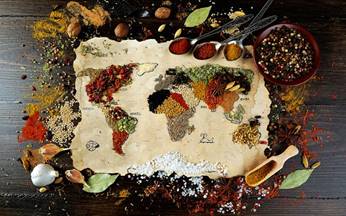
Different peoples have their own ideas about cooking: some food is close to us, and some is not. Some products we consume daily, and others we will never try. Determine the country by culinary masterpiece.
1) Gratin is a dish of vegetables, meat and seafood baked in the oven until a crust forms, invented in this country:
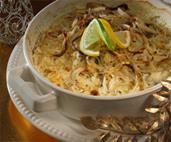
a. Italy b. France c. Spain d. Lithuania
2) An analogue of Russian cabbage rolls, the cake "Tyun", which includes rice, beans, cabbage leaves and pork, appeared in this country:
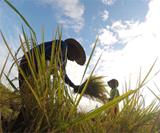
a. Vietnam b. China c. Japan d. Thailand
4. Farfalle, or butterfly pasta, has become the property of this cuisine of the world:

a. French b. Italian c. Polish d. German
4) In which country did pudding come up?
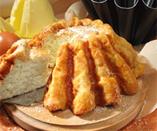
a. Sweden b. Switzerland c. Belgium d. England
5) In this country, they eat rotten shark meat, which is called haukar

a. Finland b. Iceland c. Norway d. Sweden:
6) A product made of dough with cottage cheese - placinda, to which apples and nuts are also added— is very popular in this country:
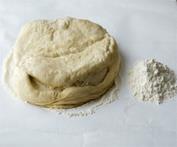
a. Kazakhstan b. Moldova c. Ukraine d. Uzbekistan
7) Tortillas - tortillas with stuffing, which are traditionally cooked over an open fire, were invented...
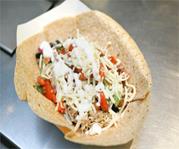
a. Mexicans b. Portuguese c. Brazilians d. Spaniards
8) One of the most popular dishes in Russia — goulash - was a dish of shepherds in this country:

b. Poland b. Hungary c. Slovakia d. Slovenia
9) Which cuisine of the world does tobacco chicken belong to?
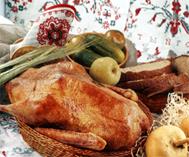
a. Georgian b. Russian c. Azerbaijan d. Ukrainian
10) A soup called "Kejanguk" is made from meat that is unusual for Europeans from...

a. Pakistan b. Korea c. Indonesia d. Mali
«Сooking quiz»
«By country and continent»
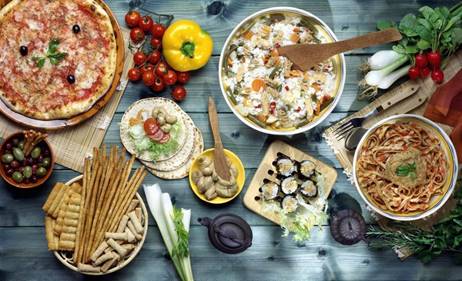
1. «Countries and peoples. Oh, these morals!»
1. In medieval Japan, all samurai, from the shogun (military ruler) to ordinary soldiers, received food rations, the size of which depended on the position of the samurai. What product made up these rations?
2. In some restaurants in the USA, for a particularly high fee, you can try roast meat from these prehistoric animals. Meat is delivered by planes from Alaska.
3. The proverb of this country claims that everything is suitable for a cook except the Moon and its reflection in the water.
4. What is the product familiar to all of us in Japanese national cuisine that replaces soy sauce?
5. In the XIX century, Talleyrand said about this country that there are thirty-two religions in it, but only one dish. And even that is bad. Many gourmets are now ready to subscribe to this statement.
6. It's hard to believe, but for divulging the secret of cooking this delicacy, the pastry chef of the English monarch was threatened with the death penalty. This is a treat…
2. «Popular Quotes»
1. According to the English writer D. Galsworthy, "this drink should be strong as a Negro, black as night, and sweet as the first kiss. What kind of drink was it about
2. What, according to the Polish satirist Lez, opens any mouth?
3.. According to A. Chekhov, a hungry dog believes only in ... This is a kind of product. Name it.
4. From which book are taken these prophetic, winged words "Man does not live by bread alone.
5. The well-known proverb says "who does not take risks, does not drink this drink" What kind of drink was it about?
6. What kind of product did the poet of the Middle Ages Victor Mazy leave us these words "... you are poetry, you are the bouquet of our dinner. What would life mean if you weren't there?" There are a great many varieties of this product from milk. What kind of product is it?
3. «A little humor»
1. It is with these tools that the glutton digs his grave. (With fork and teeth)
2. Everyone has known this instructive story about the long journey of a bakery product to the consumer since childhood.
3. Which vegetable was taken from Panikarovsky by Ostap Bender with the words: "Don't make a cult out of food"?
4. "And the wise Voltaire doubted the poison. this drink, which is native to Brazil. What kind of drink are we talking about?
5. The largest berry in the world translates as "melon with water. Tell me, what kind of berry is this?
4. «History lovers»
1. This drink was the first European to taste the Spanish conquistador Cortes.
2. In ancient India, this harmful insect, which eats all plants indiscriminately, was considered edible, since it allegedly tastes like a shrimp. What kind of insect is this?
3. At feasts in medieval Russia, when granting a guest bread, the tsar expressed hospitality and location, and the award of which product expressed royal love?
4. This salad, which decorates any table, was first prepared by a Frenchman named Lucien, the owner of the Hermitage inn, the salad then included: grouse.,tongue and caviar. Call this salad?
5. 100 years ago, the American pharmacist Pemberton brewed medicine from different ingredients in his yard, as a result, a brown syrup with a taste of plants and nuts turned out, and when the pharmacist mixed the medicine with soda water, a wonderful carbonated drink turned out. He is still the most popular in the world. Name it?
6. In 1757, during the siege of Mahon by the British, French chefs diversified the menu of the besieged with a new dish made from eggs and Provencal butter. What kind of product is it?
5. «The Kingdom of Flora»
1. This tropical fruit grows on a palm tree, is mentioned in the famous poem by V. Mayakovsky and is a decoration of the New Year's table. Name this fruit?
2. About the love of which three fruits is told in the famous Italian fairy tale?
3. This well-known vegetable in Italy is called "golden apple", "pomo-d-ore", and in France - "apple of love", "pomo-de-amour".
4. The Volga Germans from Sarepta were the first in Russia to cultivate this herb, from which they make a well-known seasoning, in 1709. What is it called?
5. With this vegetable, the hero of Jack London's story named Smoke Bellew successfully treated scurvy. 6. Which vegetable is very well stored until spring, and therefore in Russia during Lent, it was eaten in Russia more than turnips, cabbage and carrots, for which it was called a "penitent" vegetable?
6. «And how is it in Russian?»
1. This light airy cake got its name from the French word "kiss".
2. The Italian name of this dish can be translated into Russian by the word "dough". And what do we call it?
3. Tatars, Uzbeks and Kazakhs call it "katyk", Georgians - "matsoni", Tajiks - "churgot", Egyptians - "leben", and what is it called in Turkey, Greece, Romania and throughout Europe?
4. According to the French, it can decorate any dish, it is served with meat and fish.
5. Remember one musical term and try to say in French literally "a dish of different kinds of meat and herbs."
Скачано с www.znanio.ru
Материалы на данной страницы взяты из открытых источников либо размещены пользователем в соответствии с договором-офертой сайта. Вы можете сообщить о нарушении.